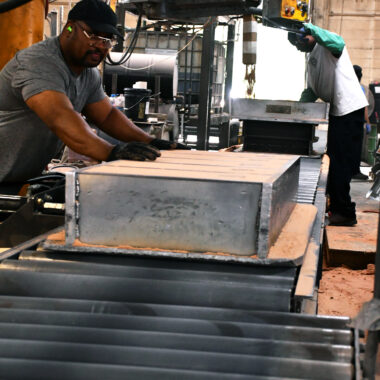About Aluminum Casting Fundamentals: Whatever You Required to Know
About Aluminum Casting Fundamentals: Whatever You Required to Know
Blog Article
Crafting Perfection: Just How to Attain High-Quality Light Weight Aluminum Castings Every Time
In the world of aluminum casting, the pursuit of excellence is a continual journey that requires a meticulous approach and an eager understanding of the ins and outs included. Accomplishing consistent top quality aluminum castings requires a detailed grasp of the procedures, from picking the proper alloy to carrying out accurate mold and mildew styles and diligently controlling spreading criteria. The real proficiency lies in the capability to implement these elements effortlessly to create perfect castings every time. As we discover the complexities of crafting excellence in aluminum spreadings, uncovering the key methods and techniques that cause impeccable results ends up being extremely important for those pursuing excellence in this customized field.
Comprehending Light Weight Aluminum Spreading Procedures
Aluminum casting processes, vital in the production sector, entail the complex transformation of molten aluminum into strong kinds via a collection of meticulously controlled steps. Understanding these processes is critical to accomplishing high-grade aluminum spreadings continually - about aluminum casting. The key approaches used in light weight aluminum spreading are pass away casting, sand spreading, and investment casting

Each of these processes has its advantages and is selected based upon factors like complexity, volume, and desired finish of the aluminum casting. about aluminum casting. Comprehending the ins and outs of these approaches is crucial for makers aiming to create top notch light weight aluminum spreadings regularly
Picking the Right Aluminum Alloy
Choosing the appropriate light weight aluminum alloy is a critical decision in the manufacturing of high-grade aluminum castings. The selection of alloy significantly influences the homes and qualities of the final item. Different light weight aluminum alloys use differing levels of toughness, rust resistance, machinability, and thermal conductivity. When selecting a light weight aluminum alloy for spreading, it is important to consider the details requirements of the application to guarantee ideal efficiency.
One of the most frequently made use of aluminum alloys for spreading is A356 - about aluminum casting. For applications requiring high strength, 7075 aluminum alloy is a prominent option due to its exceptional strength-to-weight ratio.
In addition to mechanical buildings, factors to consider such as price, accessibility, and post-casting procedures need to also affect the option of the appropriate aluminum alloy. By carefully evaluating these factors, manufacturers can guarantee the production of premium aluminum castings that fulfill the wanted specifications.
Implementing Correct Mold And Mildew Style
Developing an efficient mold layout is critical for making sure the effective manufacturing of premium aluminum spreadings. Appropriate mold style plays a significant duty in accomplishing the desired attributes of the last product. To implement an effective internet mold design, elements such as product flow, cooling prices, and part geometry must be meticulously taken into consideration.
One key facet of mold design is ensuring appropriate filling and solidification of the light weight aluminum within the mold cavity. This involves creating runner and gating systems that assist in smooth metal circulation and prevent defects such as air entrapment or incomplete filling. In addition, including air conditioning networks right into the mold and mildew design assists regulate solidification rates and lower the danger of porosity or shrinking defects.

Controlling Spreading Parameters

Making Sure Post-Casting High Quality Checks
To maintain the high top quality of aluminum spreadings, thorough post-casting high quality checks are important. After the casting process is completed, it is vital to guarantee that the last products fulfill the desired standards and specs. Among the primary high quality checks involves evaluating the surface coating of the spreadings to identify any type of defects such as porosity, fractures, or surface irregularities. This aesthetic inspection is usually supplemented by non-destructive testing techniques like ultrasonic screening or color penetrant evaluation to detect interior imperfections that might compromise the integrity of the spreading.
Dimensional accuracy is an additional critical facet that should be confirmed throughout post-casting high quality checks. Dimensions of key dimensions and tolerances ought to be taken to confirm that the castings satisfy the needed specs. Furthermore, mechanical residential or commercial properties such as firmness, tensile toughness, and influence resistance might require to be examined with material screening to make certain that the spreadings have the required stamina and durability for their designated application.
Verdict
Finally, accomplishing premium light weight aluminum castings calls for a comprehensive understanding of the casting procedures, choosing the suitable alloy, designing mold and mildews successfully, regulating spreading specifications carefully, and conducting post-casting top quality checks faithfully. By complying with these actions, producers can consistently generate aluminum castings that meet the highest possible requirements of quality and efficiency.
Attaining regular top notch aluminum spreadings demands a thorough grasp of the procedures, from selecting the ideal alloy to performing accurate mold and mildew styles and diligently managing spreading parameters. The primary methods utilized in light weight aluminum casting are pass away casting, sand spreading, and financial investment spreading.
Investment spreading, additionally understood as precision spreading, involves producing wax patterns that are covered in ceramic to form mold and mildews.Selecting the proper aluminum alloy is an important decision in the manufacturing of top notch light weight aluminum castings.Making sure specific control over casting parameters is crucial for keeping uniformity and quality in aluminum casting manufacturing.
Report this page